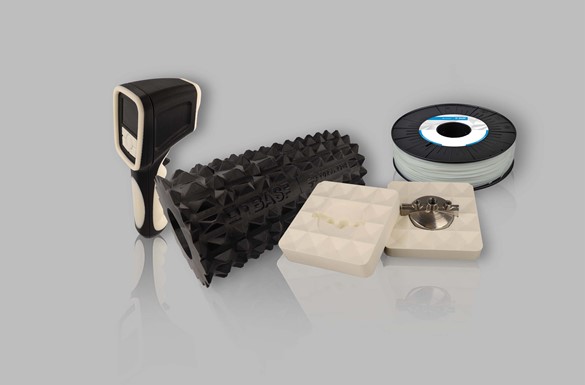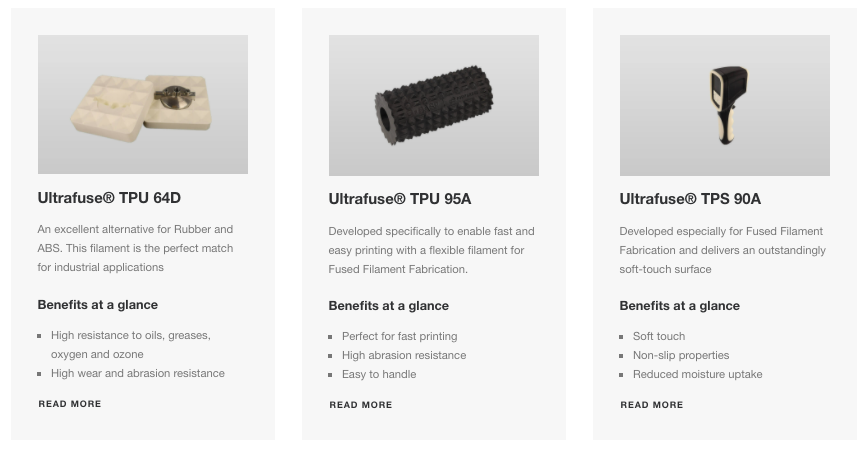BASF, one of the largest businesses in the 3D printing industry, is slowly rolling out its 3D printing materials with the possibility of overshadowing existing players in the space. Its latest line is a series of flexible filaments meant for “easy, rapid and cost- efficient production of 3D printed parts via Fused Filament Fabrication (FFF).”

The Forward AM Ultrafuse Flexible Filament Portfolio is made up of three materials: Ultrafuse TPU 64D, Ultrafuse TPU 95A and Ultrafuse TPS 90A. All three are meant to be soft, yet durable and offer mechanical strength and abrasion resistance, thus making them useful for industrial applications.
“Flexible materials surround us in our daily lives, in automotive manufacturing and production tools as well as in household appliances and consumer goods. In developing our Flexible Filament Portfolio we leveraged the decades of experience BASF has gathered in flexible materials such as Elastollan for traditional manufacturing. We are now transferring this expertise to AM to support our customers in realizing next-level industrial 3D printing applications with the very best flexible filaments on the market,” said Roger Sijlbing, Head of Sales and Marketing, Additive Extrusion Solutions at BASF 3D Printing Solutions GmbH.
Ultrafuse TPU 64D is the hardest of the elastomers in the series, with high rigidity and flexibility, making it ideal for impact-resistant parts. Ultrafuse TPU 95A is meant for quick and easy printing, while maintaining durability and flexibility, as well as abrasion resistance. For this reason, Forward AM, suggests its use for wear-and-tear applications. Finally, there’s Ultrafuse TPS 90A, which offers “unprecedented soft-touch surface haptics, giving printed parts a non-slip touch and feel.” It demonstrates low moisture uptake and “convincing layer adheision”, which BASF suggests makes it ideal for two component parts and appliance grips.

These new materials complement Forward AM’s existing flexible filaments, Ultrafuse TPU 85A and Ultrafuse TPC 45D. BASF believes that these newer filaments can be used for industrial applications, which has so far been difficult to achieve with existing materials on the market.
While firms such as NinjaTek have been working on flexible filaments for years, earning a great deal of consumer loyalty, it’s hard not to imagine a company like BASF taking over the market by sheer size, force, and finance alone. Meanwhile, the company has spun out a 3D printing service bureau dedicated to spare parts. I have little doubt that a reckoning is coming for others in the space, unless they get acquired by BASF or one of its competitors, like Mitsubishi Chemical.
Subscribe to Our Email Newsletter
Stay up-to-date on all the latest news from the 3D printing industry and receive information and offers from third party vendors.
You May Also Like
Further Understanding of 3D Printing Design at ADDITIV Design World
ADDITIV is back once again! This time, the virtual platform for additive manufacturing will be holding the first-ever edition of ADDITIV Design World on May 23rd from 9:00 AM –...
3D Printer Maker EVO-tech Reborn as NEVO3D — Once More With Feeling
EVO-tech was a 3D printing service and original equipment manufacturer established in 2013 and based in Schörfling am Attersee, Austria. The company produced high-quality material extrusion systems featuring linear bearings,...
3D Systems Brings 3D Printed PEEK Cranial Implant to the U.S. with FDA Clearance
For more than 10 years, 3D Systems (NYSE:DDD) has worked hand-in-hand with surgeons to plan over 150,000 patient-specific cases, and develop more than two million instruments and implants from its...
CDFAM Returns to Berlin for Second Annual Symposium
The second CDFAM Computational Design Symposium is scheduled for May 7-8, 2024, in Berlin, and will convene leading experts in computational design across all scales. Building upon the first event...































